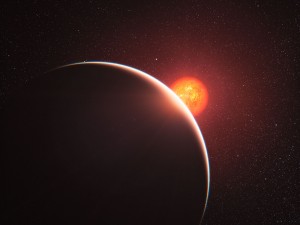A Steamy Earthlike Planet?
Having already found more than 500 planets circling distant stars, scientists are getting better at understanding what they’re made of. A group led by Jacob Bean at the Harvard-Smithsonian Center for Astrophysics reports in this week’s Nature that they’ve analyzed the atmosphere of a planet only sl…

Having already found more than 500 planets circling distant stars, scientists are getting better at understanding what they're made of. A group led by Jacob Bean at the Harvard-Smithsonian Center for Astrophysics reports in this week's Nature that they've analyzed the atmosphere of a planet only slightly larger than our own for the first time. And they may have found water —or rather, steam.
The planet, called GJ 1214b, has a radius about 2.6 times larger than Earth's, and orbits a star located 40 light-years away in the direction of the constellation Ophiuchus. Scientists knew from previous observations that the planet must have an atmosphere, because its density is too low for an all-rocky planet. Theoretical models suggest three possibilities: A) a cloud-free hydrogen atmosphere, B) high clouds or haze obscuring a deeper hydrogen atmosphere, and C) an atmosphere made mostly of water vapor.
Bean and his colleagues used the 3.6-meter Very Large Telescope in Chile to analyze the spectrum of starlight filtering through the planet's atmosphere. The data led them to rule out option A and favor option C, the steam world (although B is still a possibility). And future infrared observations should be able to distinguish between B and C.
Sadly, though, "the planet would not harbor any liquid water due to the high temperatures present throughout its atmosphere," say the authors.